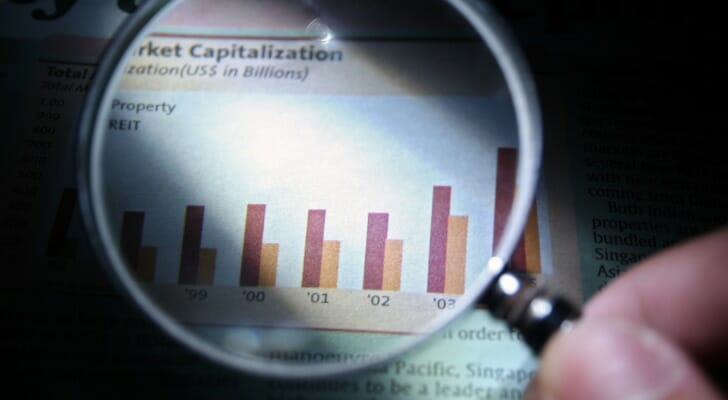Market capitalization, often abbreviated as market cap, is a measure of a public company’s overall value of its shares of stock as set by the market. Market cap can be used to compare companies, or to measure success over time. It is also a tool to help diversify a portfolio of investments and manage risk and return for individual investors. The market cap of a given company is generally easy to find, though you can also calculate it yourself. If you’re trying to figure out how to apply a market cap to your portfolio then you may want to work with a financial advisor who can manage it for you.
Calculating Market Cap
Calculating the market cap is simple: Multiply the number of outstanding shares times the share price. So a company with 10 million shares trading at $50 is worth 10 million times 50, or $500 million.
Investors prefer market cap over other figures such as sales or assets for describing a company’s value. When Apple was declared the world’s first trillion-dollar public company in August 2018, the market cap was the metric. Apple’s share price climbed to $207.39; that figure, multiplied by the 4,829,926,000 shares Apple had recently announced were outstanding, came to just over $1 trillion.
Apple, Microsoft and Amazon each have been named the world’s most valuable companies at different times in recent years. As each cycle through the top spot, or when another company challenges the leaders, the market cap will be the measure used to make the claim.
Finding Market Cap
There’s usually no need for an investor to calculate market cap. This is a standard valuation measure, which means that it will be included in the statistical profile of a public company by almost any market information service.
If the market cap is not already calculated, check the company’s balance sheet. Under shareholder’s equity will be a line item for common stock. This is the class of stock most investors buy. There may also be a line item for preferred stock. This is a special class of shares that often pays dividends.
Another line item may refer to treasury stock. These are shares the company has repurchased. To get the number of total shares outstanding, add preferred and common shares. Then subtract treasury shares. Multiply the result times the share price to get a market cap.
Market Cap Categories
Public companies are ordinarily divided into three categories according to market cap: Large, mid-sized and small.
- Large-cap companies usually have a market cap of $10 billion and up.
- Mid-cap companies usually have a market cap of $2 billion to $10 billion.
- Small-cap companies usually have a market cap of less than $2 billion.
Sometimes companies with market caps of more than $200 billion are labeled mega-caps. At the other end, companies with market cap of less than $300 million may be labeled micro-caps.
By providing a quick glimpse at the value of a company, market cap lets you easily compare and classify companies. And that can be very useful to investors seeking to diversify a portfolio.
Market Cap Uses
A large-cap company is likely to have more assets and more capital and be a less risky investment. Small and mid-cap companies, on the other hand, are likely to have greater growth potential, though with more risk because they’re less established.
Market cap helps investors diversify and balance risk and return. They can invest in large caps to reduce risk and weather market shake-ups, for example, and invest in small caps in search of higher returns. (Of course, this is just the beginning of diversifying your portfolio; you should also mix in some international stocks, as well as bring in fixed-income investments to hedge against market risk.)
Mutual funds are often categorized by whether their holdings are concentrated in large-caps, mid-caps or small-cap. A mutual fund profile will generally include information about which category of market cap it emphasizes.
Insights From the Market Cap
Knowing a company’s market cap is more useful than knowing its share price alone. That’s because a company with a high share price may be less valuable than another company with a lower share price but more shares outstanding.
Even market cap, however, doesn’t necessarily indicate a company’s fundamental value. Rather, it reflects what the market perceives its value to be. Markets often under-value or over-value shares relative to their fundamental value.
This can happen for a number of reasons. For instance, sometimes companies can be broken up into parts that separately are worth more than the market cap of the intact enterprise. This can be the case when one part of the company is performing poorly and dragging down the value of the better-performing parts.
How Market Cap Changes Over Time
Market cap can change if the company’s share price increases. This, of course, is what happened to make Apple the first trillion-dollar non-state public company.
Companies that repurchase shares will see their market cap decline, as there are now fewer shares outstanding. However, that assumes share prices remain stable; in practice, share buybacks often increase a company’s share price, at least in the short term.
A stock split, on the other hand, can change share value, but won’t change market capitalization. A company with 10 million shares trading at $10 apiece has a market cap of $100 million. If it does a 2-for-1 split it will have 20 million shares trading at $5 after the split. So the market cap remains $100 million after the split.
The Bottom Line
A market cap, or market capitalization, is a way to assign an estimated value to shares of stock for a specific company. Individual investors can use market caps to assign certain levels of risk and investment choices within their portfolios. The market cap for a company typically changes as the share price goes up and down and a company can decide to take action, such as splitting the stock. It’s important to pay attention to market cap if you’re actively managing the risk within your portfolio at all times.
Tips for Optimizing Your Portfolio
- If you’re interested in building a well-diversified investment portfolio, it might be a good idea to talk to a financial advisor. Finding the right financial advisor that fits your needs doesn’t have to be hard. SmartAsset’s free tool matches you with up to three financial advisors who serve your area, and you can interview your advisor matches at no cost to decide which one is right for you. If you’re ready to find an advisor who can help you achieve your financial goals, get started now.
- If you’ve only got a little money to invest in the market, you may be better off working with a robo-advisor. These investing services will determine your ideal asset allocation and then build you an investment plan, without the need for the minimum investments required by traditional advisors.
Photo credit: ©iStock.com/anyaberkut, ©iStock.com/Weim, ©iStock.com/MicroStockHub


